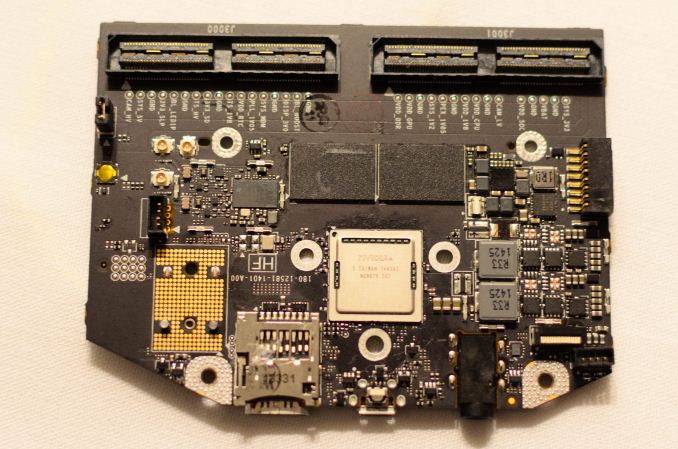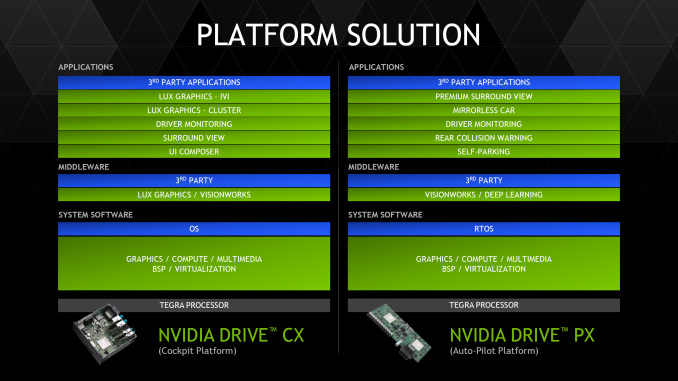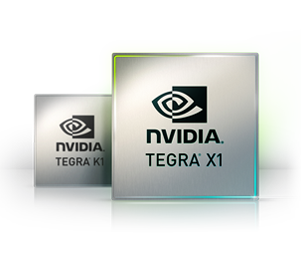NVIDIA Tegra X1 Preview & Architecture Analysis
by Joshua Ho & Ryan Smith on January 5, 2015 1:00 AM EST- Posted in
- SoCs
- Arm
- Project Denver
- Mobile
- 20nm
- GPUs
- Tablets
- NVIDIA
- Cortex A57
- Tegra X1
Final Words
With the Tegra X1, there have been a great deal of changes when compared to Tegra K1. We see a move from Cortex A15 to A57 on the main cluster, and a move from a single low power Cortex A15 to four Cortex A53s which is a significant departure from previous Tegra SoCs. However, the CPU design remains distinct from what we see in SoCs like the Exynos 5433, as NVIDIA uses a custom CPU interconnect and cluster migration instead of ARM’s CCI-400 and global task scheduling. Outside of these CPU changes, NVIDIA has done a great deal of work on the uncore, with a much faster ISP and support for new codecs at high resolution and frame rate, along with an improved memory interface and improved display output.
Outside of CPU, the GPU is a massive improvement with the move to Maxwell. The addition of double-speed FP16 support for the Tegra X1 helps to improve performance and power efficiency in applications that will utilize FP16, and in general the mobile-first focus on the architecture makes for a 2x improvement in performance per watt. While Tegra K1 set a new bar for mobile graphics for other SoC designers to target, Tegra X1 manages to raise the bar again in a big way. Given the standards support of Tegra X1, it wouldn’t be a far leap to see more extensive porting of games to a version of SHIELD Tablet with Tegra X1.
NVIDIA has also made automotive applications a huge focus in Tegra X1 in the form of DRIVE CX, a cockpit computing platform, and DRIVE PX, an autopilot platform. Given the level of integration and compute present in both DRIVE CX and PX, there seems to be a significant amount of value in NVIDIA’s solutions. However, it remains to be seen whether OEMs will widely adopt these solutions as car manufacturers can take multiple years to implement a new SoC. Compared to the 3-4 month adoption rate of an SoC in a phone or tablet, it's hard to pass any judgment on whether or not NVIDIA's automotive endeavors will be a success.
Overall, Tegra X1 represents a solid improvement over Tegra K1, and now that NVIDIA has shifted their GPU architectures to be targeted at mobile first, we’re seeing the benefits that come with such a strategy. It seems obvious that this would be a great SoC to put in a gaming tablet and a variety of other mobile devices, but it remains to be seen whether NVIDIA can get the design wins necessary to make this happen. Given that all of the high-end SoCs in the Android space will be shipping with A57 and A53 CPUs, the high-end SoC space will see significant competition once again.













194 Comments
View All Comments
Jumangi - Monday, January 5, 2015 - link
Apple would never use Nvidia at the power consumption levels it brings. The power is pointless to them if it can't be put into a smartphone level device. Nvidia still doesn't get why nobody in the OEM market wants their tech for a phone.Yojimbo - Monday, January 5, 2015 - link
But the NVIDIA SOCs are on a less advanced process node, so how can you know that? You seem to be missing the whole point. The point is not what Apple wants or doesn't want. The point is to compare NVIDIA's GPU architecture to the PowerVR series 6XT GPU. You cannot directly compare the merits of the underlying architecture by comparing performance and power efficiency when the implementations are using different sized transistors. And the question is not the level of performance and power efficiency Apple was looking for for their A8. The question is simply peak performance per watt for each architecture.OreoCookie - Tuesday, January 6, 2015 - link
@YojimboThe Shield was released with the Cortex A15-based Tegra K1, not the Denver-based K1. The former is not competitive with regards to CPU performance, the latter plays in the same league. AFAIK the first Denver-based K1 product was the Nexus 9. Does anyone know of any tablets which use the Denver-based K1?
lucam - Wednesday, January 7, 2015 - link
Apple sell products that have an year life cycle, don't sell chips and therefore they don't need to do any marketing in advance as NV does punctually at any CES.TheJian - Monday, January 5, 2015 - link
It's going finfet 16nm later this year (parker). As noted here it's NOT in this chip due to time to market and probably not as much gained by shrinking that to 20nm vs. going straight to 16nm finfet anyway. Even Qcom went off the shelf for S810 again for time to market.Not sure how you get that Denver is a disappointment. It just came out...LOL. It's a drop in replacement for anyone using K1 32bit (pin compatible), so I'm guessing we'll see many more devices pop up quicker than the first rev, but even then it will have a short life due to X1 and what is coming H2 with Denver yet again (or an improved version).
What do you mean K1 is in ONE device? You're kidding right? Jeez, just go to amazon punch Nvidia K1 into the search. Acer, HP, NV shield, Lenovo, Jetson, Nexus9, Xiaomi (mipad not sold on amazon but you get the point)...The first 4 socs were just to get us to desktop gpu. The real competition is just starting.
Building the cpu wasn't just for mobile either. You can now go after desktops/higher end notebooks etc with NO WINTEL crap in them and all the regular PC trimmings (high psu, huge fan/heatsink, hd's, ssd's etc etc, discrete gpu if desired, 16-32GB of ram etc). All of this timed perfectly with 64bit OS getting polished up for MUCH more complicated apps etc. The same thing that happened to low-end notebooks with chromebooks, will now happen with low end PC's at worst and surely more later as apps advance on android etc and Socs move further up the food chain in power and start running desktop models at 4ghz with fan/heatsinks (with a choice of discrete gpu when desired). With no Wintel Fee (copy of windows + Intel cpu pricing), they will be great for getting poor people into great gaming systems that do most of what they'd want otherwise (internet, email, docs, media consumption). I hope they move here ASAP, as AMD is no longer competition for Intel CPU wise.
Bring on the ARM full PC like box! Denver was originally supposed to be x86 anyway LOL. Clearly they want in on Intel/AMD cpu territory and why not at CPU vs. SOC pricing? NV could sell an amped up SOC at 4ghz for $110/$150 vs. Intel's top end i5/i7's ($229/339). A very powerful machine for $200 less cash but roughly ~perf (when taking out the Windows fee also, probably save $200 roughly). Most people in this group won't miss the windows apps (many won't even know what windows is, grew up on a phone/tablet etc). Developing nations will love these as apps like Adobe Suite (fully featured) etc get moved making these cheap boxes powerful content creators and potent gamers (duh, NV gpu in them). If they catch on in places like USA also, Wintel has an even bigger headache and will need to drop pricing to compete with ARM and all it's ecosystem brings. Good times ahead in the next few years for consumers everywhere. This box could potentially run android, linux, steamos, chrome in a quadboot giving massive software options etc at a great price for the hardware. Software for 64bit on Arm will just keep growing yearly (games and adv apps).
pSupaNova - Tuesday, January 6, 2015 - link
Agree totally with your post, NVdia did try to put good mobile chips in netbooks with the ION & ION2 and Intel blocked them.Good to see that they have stuck at the job and now are in the position to starting eating Intels lunch.
darkich - Monday, January 5, 2015 - link
That's just not true.The K1 has shipped in three high end Android Tablets - Nvidia shield, Xiaomi MiPad, and Nexus 9.
Now, how many tablets got a Snapdragon 805?
Exynos 5433?
Tegra K1 market performance is simply the result of the fact that high end tablet market is taken up by Apple, and that it doesn't compete in mod range and low end.
darkich - Monday, January 5, 2015 - link
*mid rangeGC2:CS - Monday, January 5, 2015 - link
It's the result of too high power compustion, that OEM's prefer to keep low.That's why tegra K1 is used by just foolish chinesse manufacteurs (like tegra 4 in a phone) like xiaomi, google in a desperate need for a non Apple high end 64-bit chip (to showcase how much it's 64-bit) and nvidia themselves.
Yojimbo - Monday, January 5, 2015 - link
I think you're right that the K1 is geared more towards performance than other SOCs. The K1 does show good performance/watt, but it does so with higher performance, using more watts. And you're right that most OEMs have preferred a lower power usage. But it doesn't mean that the K1 is a poor SOC. NVIDIA is trying to work towards increasing the functionality of the platform by allowing it to be a gaming platform. That is their market strategy. It is probably partially their strategy because those are the tools they have available to them; that is their bread-and-butter. But presumably they also think mobile devices can really be made into a viable gaming platform. Thinking about it in the abstract it seems to be obvious... Mobile devices should at some point become gaming platforms. NVIDIA is trying to make this happen now.